
Industrial design is a multifaceted discipline that ensures the functionality, aesthetics, manufacturability, and sustainability of the everyday products we use. From coffee machines to electric scooters, from toothbrushes to office furniture—each product has an industrial design process behind it.
This field trains creative professionals who blend user needs, technical constraints, and aesthetic concerns. Students in industrial design programs develop both manual and digital skills, learning to generate tangible solutions to real-world problems at the intersection of art, engineering, and business.
Who Is It For?
Industrial design is ideal for students who possess both creative and analytical thinking skills. Individuals who are motivated to improve lives through design and enjoy the process of turning an idea into a physical product are likely to thrive in this field.
Key characteristics of successful candidates include:
- The ability to evaluate aesthetics and functionality together
- Strong observation skills, empathy, and awareness of user experience
- Visual communication skills (drawing, modeling)
- Patience, discipline, and a project-oriented mindset
Students with interests in technical subjects (math, geometry, physics) as well as visual arts, design, and information technologies are particularly well-suited for this discipline.
In Türkiye Industrial Design require a Quantitative (SAY) score.
Program Structure and Curriculum
The standard duration of the program in Türkiye is four years, combining theory, practical work, and studio projects. From the first year, students engage in model-making, user analysis, and ideation. In later years, they transition to digital modeling and production using CAD software.
Typical core courses include:
- Basic Design and Technical Drawing
- Material Science and Manufacturing Methods
- Ergonomics and User Experience
- Design History and Marketing
- CAD/CAM/3D Modeling
- Studio Projects and Design Critique
Industrial Design Around the World
Internationally, industrial design programs may fall under two distinct academic structures:
| Faculty Type | Program Title Example | Focus Areas |
|---|---|---|
| Faculty of Engineering | Industrial Design Engineering (e.g., TU Delft) | Technical aspects, production, engineering basis |
| Faculty of Art & Design | Industrial Design / Product Design (e.g., RCA, UAL) | Creativity, aesthetics, user experience |
Career Paths for Graduates
Industrial design graduates can contribute at various stages of user-centered product development. They enjoy a broad employment landscape, including:
Sectors:
- Consumer electronics and home appliances
- Furniture and interior products
- Automotive and transportation
- Healthcare and medical device design
- UX/UI and digital product design
- Startups and R&D centers
Common Job Titles:
- Industrial Designer
- Product Development Specialist
- UX/UI Designer
- Design Manager
- Modeling & Prototyping Specialist
With postgraduate education, graduates may also specialize in areas such as design management, interaction design, service design, and sustainable product development.
Why Choose Industrial Design?
Industrial design offers a future-oriented career path that nurtures hybrid skills increasingly in demand:
- Creativity + Technical Expertise: Combine engineering calculations with aesthetic sensibilities to create innovative, practical solutions.
- Diverse Work Opportunities: Work in physical and digital product design across the public and private sectors or as an entrepreneur.
- Global Employability: Especially in fields like UX/UI, designers can work remotely on international projects and earn foreign currency.
- Entrepreneurship Potential: 3D printing, rapid prototyping, and crowdfunding platforms open doors for independent product development and brand creation.



